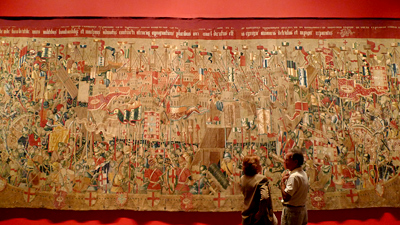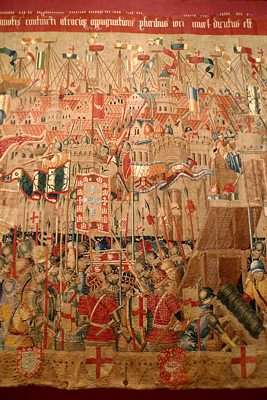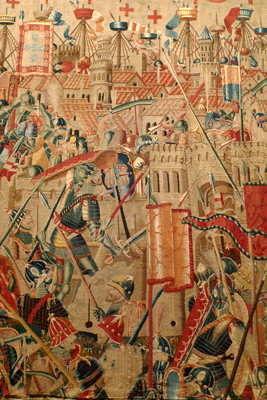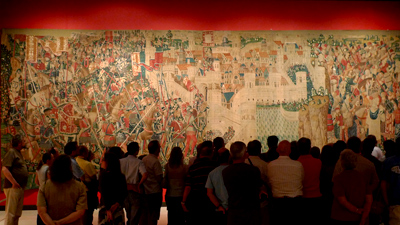
Even though I saw this temporary exhibit at the Museu Nacional de Arte Antiga when it opened in June, I returned today for a second look… mainly because these Flemish tapestries deal with two cities I’m taking groups to this year.

Recently restored & back in Portugal for the first time, these Flemish tapestries tell a Where’s Waldo version of the 1471 conquest of Asilah & Tangier by Afonso V. Meant to be read like a comic book, Latin text at the top of each tapestry explains the scene. Images of flags, coats-of-arms, weapons, city walls & even the king add the details.

For history buffs like me, ownership of the tapestries themselves presents the biggest thrill. Here’s what the Fundación de Carlos Amberes has to say about it (my translation):
It is uncertain how the panels arrived in Spain, & various hypotheses exist. On one hand, they could have been taken as booty in the Battle of Toro where Isabel la Católica faced Afonso V for control of the Spanish throne. They also could have been a personal gift from the Portuguese king to Grand Cardinal Mendoza as a gesture of gratitude for good treatment of Portuguese prisoners. It could be that they never even arrived in Portugal, forming part of Prince Felipe I the Fair’s luggage when he arrived in Castilla. With his death in 1506, they could have been sold at cost & bought by the Duke del Infantado. Of all the proposed ideas, the hypothesis which receives the most credit is that they were given to King Felipe II by Rui Gomes da Silva (Prince of Eboli) who came to have the title, among others, first Duke of Pastrana. In 1628, the tapestries were located in the palace of the Dukes del Infantado in Guadalajara. It is known that they were donated in 1664 to the Colegiata de Pastrana by the Mendoza family.

Incredible. The battle scenes are exciting to look at, & I was struck by the fact that the Moroccan cities don’t look Moroccan at all. They are Flemish interpretations based on what they knew: northern European medieval towns. Even the fortifications are inaccurate. But that does not make them less breathtaking. The exhibit is in Lisboa until September 12th, then it moves around Portugal & eventually back to Spain.